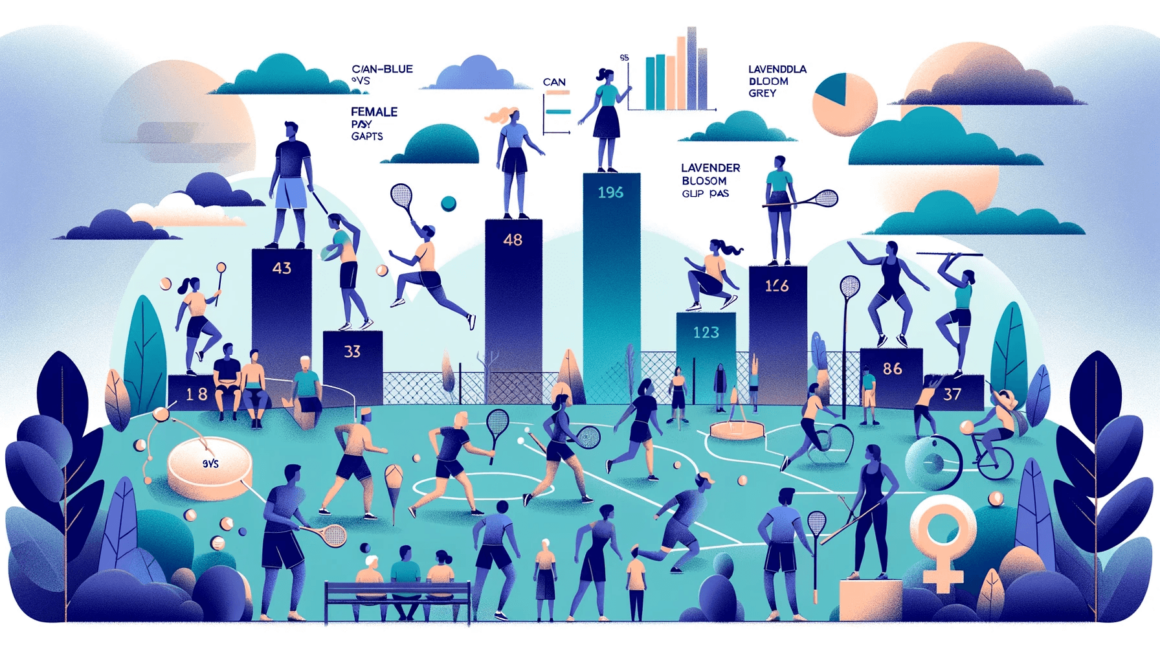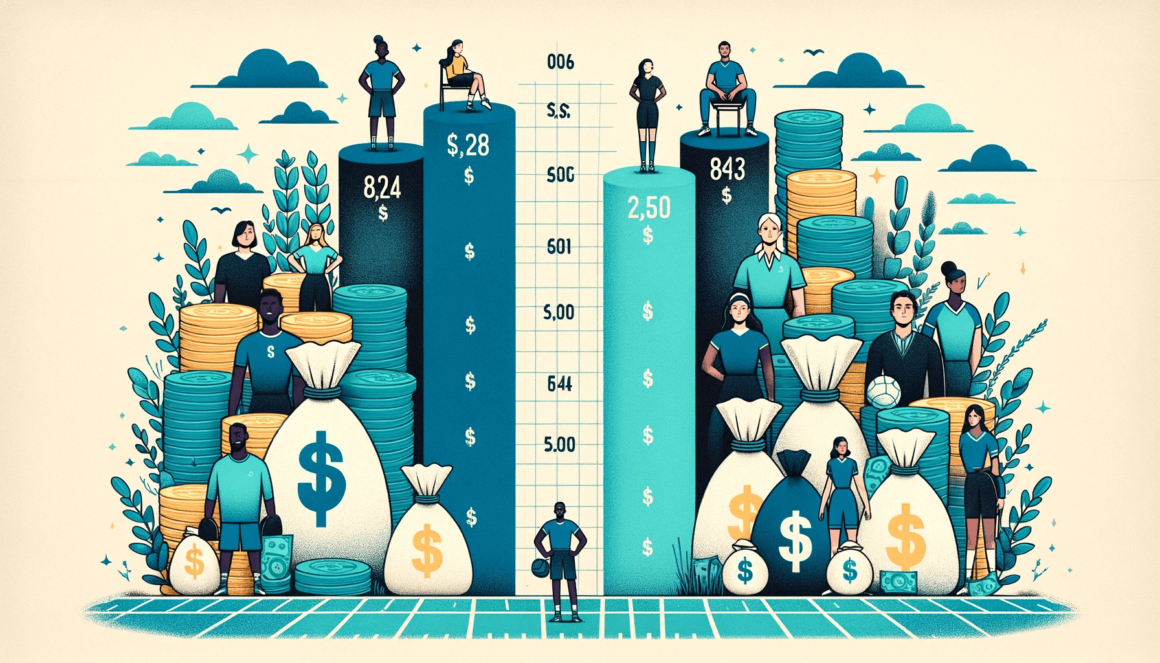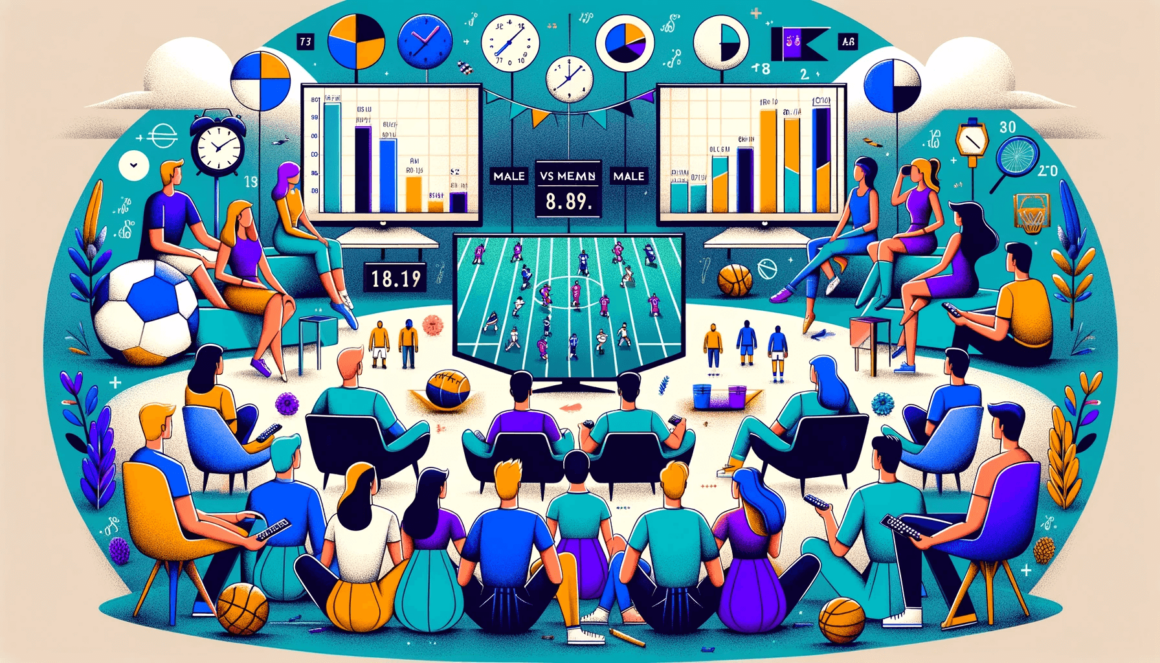Male Vs Female Sports Statistics: Is There Gender Equality Among Athletes Today?
Sporting events featuring women are rarely acknowledged compared to men’s events. A 2021 study mentioned the lack of media coverage for women’s sports as a reason for the lack of engagement compared to men’s sports coverage.
Women can compete. The sports industry hosts some of the world’s greatest female athletes of all time. They defy expectations and break the stigma, yet are undervalued and underpaid.
Let’s explore gender-related sports statistics and determine whether women athletes get equal recognition as men in the sports industry.
Highlights of the Article
- 48% of the male audience in the United States are avid fans; only 19% of the female audience say the same.
- People consume more men’s sports than women’s sports content in most countries.
- Broadcast rights for men’s NCAA tournaments sold for $10.18 billion in 2010, while women’s tournaments were worth $500 million.
- WNBA players earn a maximum of $215,000, while NBA players have a salary cap of $123,655,000.
- The highest-paid female golfer in 2022 reached $7.3 million, while her male counterpart made $138 million.
- 45% of the general population in eight countries are willing to attend a live sporting event featuring women.
- The National Women’s Soccer League saw a 300% viewership increase in 2020.
- Operators will offer more betting options for women’s sports in the coming years.
Male vs Female Sports Statistics 2023 Overview
It’s no secret that men are physically stronger than women. In elite sports, the performance gap is 10-12%. It doesn’t mean that male athletes should get more attention or compensation.
In most popular sports, divisions, genders, and weight classes matter. That is why comparisons are unnecessary. Both genders compete hard and are fun to watch equally.
These statistics will show noteworthy discrepancies between males and females in sports.
Male vs Female Sports Market Size Statistics

The global sports industry is vast. It has many submarkets, from broadcasting and licensing to sponsorships. It is also closely associated with two other big markets: food and nutrition.
By 2023, the sports equipment market will be worth $150 billion globally. The sports apparel industry will be bigger, up to $200 billion.
Thanks to technological advancements, we now have sports betting.
The eSports market also generated a revenue of $957.5 million in 2019 and is expected to make more than $1.6 billion by 2024.
The sports pie is massive. How big of a slice are women getting? Let’s find out.
1. 48% of the male audience in the United States are avid fans; only 19% of the female audience say the same.
(Statista, Scott Scoop)
Sport is a powerful platform for empowering women of all ages. However, this perspective is not apparent in the US sports fan base.
In 2023, Statista reported that 48% of the male participants were avid fans. Only 19% of the females said the same.
The discrepancy starts at the fundamental level of their willingness to tune in.
Here’s a rundown of the results:
- Casual fans – 39% of male respondents and 46% of the females;
- Not fans – 13% of the male participants and 34% of the females.
Sports coverage is a possible reason for the gap. How the sports media portray women is vital. This challenge is hard to overcome since only 22.2% of US sports journalists are females.
2. People consume more men’s sports than women’s sports content in most countries.
(Statista)
Statista suggested that adult sports fans in 13 countries showed overwhelming interest in men’s sports compared to women’s.
The UK showed the biggest mismatch: 78% of its respondents watched more men’s sports. Only 2% of the participants watched female athletes more.
Only Mexico had more sports fans following men’s and women’s sports equally.
The statistics suggest that interest in women’s sports is low. It is a sign of poor coverage, resulting in gender stereotypes.
3. Broadcast rights for men’s NCAA tournaments sold for $10.18 billion in 2010, while women’s tournaments were worth $500 million.
(Washington Post)
In 2010, Turner and CBS bought the broadcast rights for the NCAA men’s basketball tournament. The deal was $10 billion for 14 years.
They extended it in 2016 for another eight years and $8.8 billion more.
ESPN paid $500 million in 2010 to broadcast the NCAA women’s basketball tournament, among other sports. It was also a 14-year deal ($35 million annual average).
NCAA reported that the women’s basketball tournament generated $5.7 million annually, losing $2 million annually.
Other reports say the women’s tournament earned almost $12 million annually. It averaged 4 million viewers between 2016 and 2019, making it the package prize in the 2010 deal.
4. Women’s sports is an emerging industry worth over $1 billion.
(Delloite Insights)
In 2021, Deloitte estimated that the women’s sports industry would earn less than $1 billion, including all revenue streams, such as TV rights, sponsorships, and live events.
The amount significantly increased compared to the global value of all sports in 2018, at $481 billion.
Women in athletic and non-athletic roles account for a small fraction of industry revenue. TV rights and sponsorship deals for women are scarce and pay relatively less.
However, Delloite quickly added that women’s sports could earn much more in the coming years.
Around 66% of the general population is interested in at least one women’s sport based on a multi-country study. This number increases to 84% among sports fans.
Male vs Female Sports Salary Statistics

An excellent way to evaluate gender equality in sports is through player salary.
Ideally, sports shouldn’t only be about money. However, it is the primary source of income for athletes and organizations.
Fans pay top money to watch their favorite players and teams in action. Businesses dash to advertise and sell merchandise. Media outlets spend billions to broadcast games.
While an event such as the 2019 Women’s World Cup broke records, these salary statistics show that gender bias still exists in sports.
5. Female tennis players earn an average of $283,635, while males usually make $335,946.
(Adelphi University, Human Kinetics)
The US Bureau of Labor Statistics stated that women earn 81% of what men fully make. Things are better in sports, with an average of 94%, varying from sport to sport.
In tennis, female athletes make $283,635, while male athletes earn $335,946.Tennis players are the highest-paid female athletes, yet there is still a gender pay gap.
Tennis is more mindful of gender equality. Their fight for equal pay started in 1970 when nine female players launched the Women’s Tennis Association.
In 1973, Billie Jean King threatened to skip the US Open because of unequal prize money. Her threatened boycott was successful, although other Grand Slams only followed suit in 2007.
6. WNBA players earn a maximum of $215,000, while NBA players have a salary cap of $123,655,000.
(The Athletic, NBC Sports, Hoops Rumors, Spotrac)
The 2020 CBA ensured a pay increase for WNBA players. From a max of $117,500, the new salary cap is now $215,000. The maximum salary of an NBA player is $123,655,000.
Stephen Curry is the NBA’s highest earner, averaging $53 million a year. Meanwhile, WNBA’s highest-paid was Diana Taurasi, with $234,936 in 2023. Two other WNBA stars also earned the same amount each.
The WNBA 2022 season was the league’s most-viewed season since 2008. However, it’s still not as profitable as the NBA.
7. Around 10% of NBA referees are female.
(NBA, Hoops Rumors, Medium, Just Women’s Sports)
The NBA was one of the first sports organizations to promote gender equality. In 2016, the NBA started holding its players accountable for domestic violence.
Still, by 2023, only 10 of the 98 NBA referees were women. The NBA has never had a female head coach.
Becky Hammon came close. Hammon was the assistant coach for the Spurs for eight years. She had interviewed for the position but did not receive an offer.
8. The highest-paid female golfer in 2022 earned $7.3 million, while her male counterpart made $138 million.
(Variety, World Atlas, Essential Golf, Essentially Sports)
Golf is the 10th biggest sport in the world, with around 450 million followers.
The winningest golf players make tens of millions in USD. Phil Mickelson led the way in 2022, with total earnings of $138 million.
However, this level of success does not extend to female golfers.
Australia’s Minjee Lee made Forbes’ list of ten highest-paid female athletes in 2022. She earned $7.3 million that year.
Male vs Female Sports Viewership Statistics

Sports is one of the US’s biggest attractions on traditional TV. NFL’s Sunday Night Football had roughly 18.4 million viewers during the 2021-22 season.
The same is true for digital platforms. In 2021, 57.5 million people consumed digital live sports at least once per month. Industry experts believe this number will rise to over 90 million in 2025.
How do women fit in amid all these viewership wins? Let’s find out.
9. 45% of the general population in eight countries is willing to attend a live sporting event featuring women.
(Nielsen)
Female athletes don’t get the same attention as male athletes — not yet, anyway.
A Nielsen study covering eight countries suggested the following about the viewing population:
- 45% would consider watching a live women’s sporting event,
- 46% would watch female athletes compete if free TV covered them
- 38% haven’t seen one but “Could be interested” in watching
The data presents an untapped potential for brands and media organizations willing to take a chance on women’s sporting events.
10. The National Women’s Soccer League saw a 300% viewership increase in 2020.
(Lines)
In 2020, 653,000 people watched the NWSL Challenge Cup. It was at the same level as MLB games in the same time slot.
The US women’s soccer team has long been an international powerhouse. They’ve been in the top 3 since the World Cup’s launch in 1991. They never enjoyed this level of viewership until now.
Three key factors probably spurred interest in women’s soccer:
- The US women’s team won the 2019 World Cup
- The women’s league started before the men’s tournament
- Improvement of the media coverage of US women’s soccer
The last factor was credited for raising visibility and players’ profiles for the league.
11. 66% of US sports fans watch more men’s sports, while 3% consume more women’s sports.
(Asking Smarter Questions, Statista)
Women comprise almost half of the US sports fan base. The NFL’s audience is 44% women, while the MLB’s is 47%.
There are as many female sports fans as males, but sports marketing focuses more on men. That is why 66% of sports fans in the US watch more men’s sports. Only 3% prefer watching women’s sports.
The data suggests that the brands and networks are missing out on the women’s sports market.
Male vs Female Sports Trend Statistics
The sports industry is growing on multiple fronts. Technological progress forces organizations to review their methods, and the socio-political climate advances gender equality issues.
Here are the most pressing sports trends to look out for in 2023:
12. eSports will continue to grow and have 500 million global fans by 2024.
(Madison Taylor Marketing)
The esports industry is becoming more popular.
By 2024, the IOC projects that the global audience base will reach 500 million fans.
The International Olympic Committee organized the first-ever Olympic eSports Week (OEW), starting on March 1, 2023. The finals will be on June 22-25 at the Suntec Centre in Singapore.
The OEW shall showcase a new breed of athletes: “professional gamers.”
It will open up fresh revenue streams involving profitable market segments, which include equitable opportunities for female competitors.
13. Operators will offer more betting options for women’s sports in the coming years.
(Deloitte)
Sports betting has thrived for over a decade in some countries. The industry is active in 31 states and earned over $42 billion in the first half of 2022.
The US did not revoke the federal ban on online gambling until 2018. It is a relative newcomer but has seen rapid growth in a few years.
At the same time, interest in women’s sports reached record highs in 2022. As the sports betting industry matures, it will likely focus more on women’s leagues.
Final Words
The sports industry is taking a firmer stand on gender equality. However, statistics show how wide the gap still is. It would take some time before we see significant improvements.
Media coverage would play a central role in this undertaking.
Put female athletes in a better light, and the rest will follow: more female fans, bigger sponsorship deals, and a better environment for women in sports.
FAQs
Is there a sport where a female athlete has beaten a male?
Yes, more often than you think. In the 2022 US Track and Field 100-mile Championships, Camille Herron finished roughly 30 minutes ahead of second-placer Arlen Glick.
Are trans athletes allowed to compete?
Transgender athletes can compete professionally, but the regulations are restrictive. The World Athletics won’t let trans athletes who went through “male puberty” participate in its events.
In which sport is gender bias most apparent?
Gender bias in team sports is problematic. The wage difference between male and female athletes is highest in basketball, baseball, and soccer.
 BC.Game
BC.Game  7Bit
7Bit  Ducky Luck
Ducky Luck  Red Dog
Red Dog